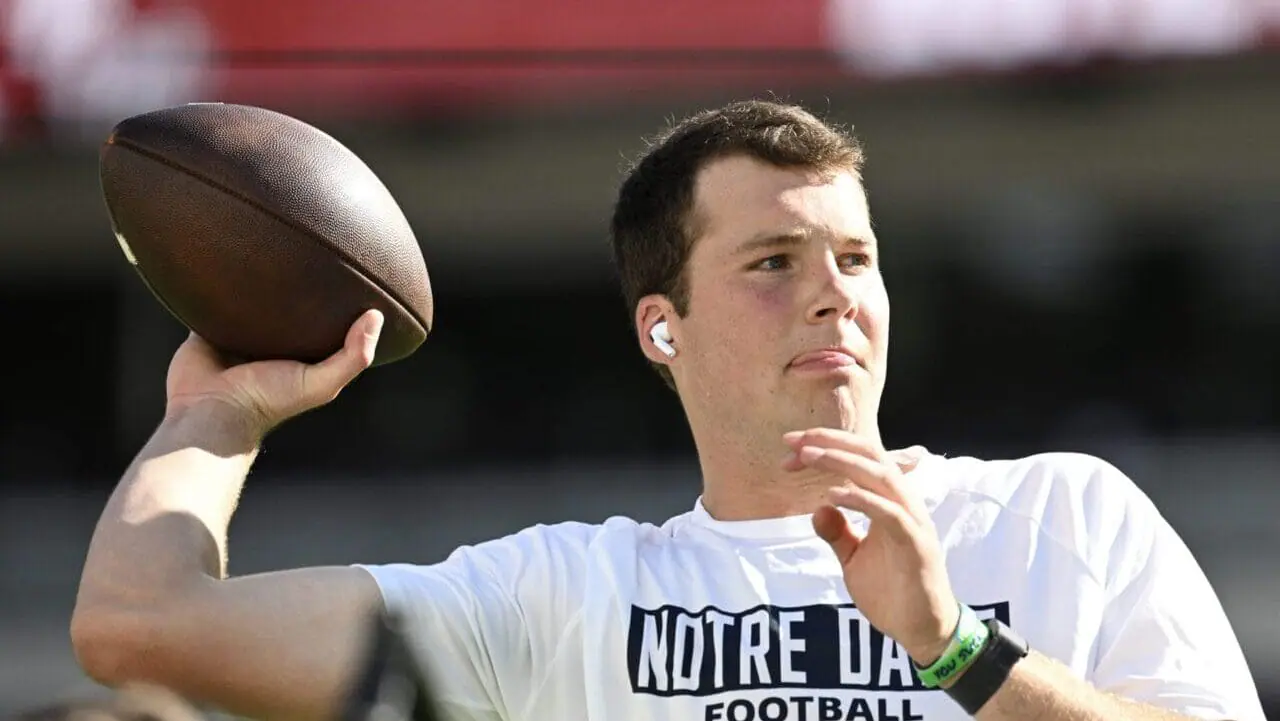No. 5 Notre Dame leans heavily on QB Riley Leonard
SOUTH BEND, Ind. (AP) — Notre Dame quarterback Riley Leonard showed his teammates what he was all about with an early scramble and a subsequent slide that drew a first-quarter targeting penalty on Texas A&M defensive back Dalton Brooks last weekend.
Leonard got up, dusted himself off and went right back to work — a business-as-usual moment that struck a chord on the Fighting Irish sideline.
“Taking a hit like he did, the targeting penalty, a lot of people would have been shaken up by that,” wide receiver Beaux Collins said. “They would have been rattled and thrown off. I felt he was poised the whole game. I didn’t see any type of worry, no type of doubt in his eyes.”
Neither did anyone else, which was a key reason coach Marcus Freeman pursued Leonard when he entered the transfer portal.
That decision already is paying dividends at Notre Dame, which moved up two spots to No. 5 in the AP Top 25 after a 23-13 victory over the then-No. 20 Aggies. Leonard threw 18 of 30 for 158 yards and ran 12 times for 63 yards.
On Saturday, he gets to do it all over again when the Irish (1-0) face Mid-American Conference opponent Northern Illinois (1-0). And after being a two-year starter at Duke, the veteran doesn’t expect any butterflies when he plays in one of college football’s most revered venues, Notre Dame Stadium.
“As the game builds up, I become more and more emotionless, because I’m more confident,” Leonard said. “Nerves come with lack of preparation. Everybody that comes to Notre Dame has a goal and a legitimate chance to go to the NFL. Everybody here is like, ‘Hey, can we watch film; hey, what do you think about this?’”
The 6-foot-4, 216-pound former Alabama prep star certainly knows about the mystique of Irish football, everything from Knute Rockne to “Rudy.” And he was part of a new chapter last season when he suffered a high sprain of his right ankle late in Duke’s 21-14 loss to Notre Dame.
Irish quarterback Sam Hartman, who played previously at Wake Forest, waited outside the injury tent after the game ended to check on Leonard. Leonard emerged on crutches, and the two briefly chatted.
Whether that influenced Leonard’s eventual decision to join the Irish this season isn’t clear. Leonard has said he chose Notre Dame because of the camaraderie he found among the players. The last few months have only confirmed his initial impression.
“We’ll be sitting in the locker room drawing up plays,” Leonard said. “When you see somebody in the facility late at night, watching film, that’s just going to drive you to go later than him and watch more film than him. That’s the atmosphere and the culture here.”
It shows with the dual-threat quarterback’s unusual leadership style.
“He’s kind of like a chill dude at all times throughout the game,” Collins said. “I didn’t know what to expect from him. He’s definitely the leader that we needed.”
Leonard brings an experienced hand, too.
He was 250 of 392 passing with 2,967 yards, 20 TDs and six interceptions during his first season as Duke’s starter but was limited by injuries last season. He threw 95 of 165 for 1,102 yards and three TDs while rushing 124 times for 699 yards and 13 scores before a season-ending left toe injury in late October.
But it’s not just what he does on the field that makes him special.
His penchant for learning has helped him thrive in Notre Dame’s offensive system and lead the team in front of a rocking, raucous 107,000 fans at Texas A&M, too.
“He picks things up fast,” Notre Dame offensive coordinator Mike Denbrock said. “I think he’s a guy who seeks details. He wants detailed information. He wants detailed feedback, whether that’s positive or negative, so he can go and learn as a player.”
But as gritty as Leonard’s start was last weekend, his finishing kick also turned heads around South Bend, giving the Irish and their fans a glimpse of how promising this season could be with Leonard behind center.
“To finish the fourth quarter with an eight-play, 85-yard TD drive that was the difference,” Freeman said. “That’s really the moment where we were able to say: ‘We have this. We’ve got the game.’”
